Bluebook
of Pianos
ARCHIVES | RATING GUIDE | MUSIC | PIANO AGE | SELL YOUR PIANO | PIANO TYPES | PIANO PRICES
Bluebook
of Pianos
ARCHIVES | RATING GUIDE | MUSIC | PIANO AGE | SELL YOUR PIANO | PIANO TYPES | PIANO PRICES
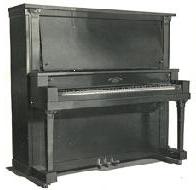
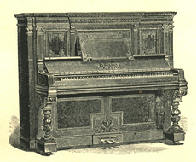
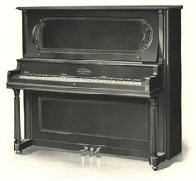
Classic & Antique & Upright Piano Grading Guide
Piano values vary with condition, age, type of wood, style and the piano market conditions in the area you live in. Rare and collectible items appreciate and it is not necessarily the age in years that best determine the accurate valuation, but more over the quality of current information and research that is used. Due to the instrument's 11,000 parts; such as different kinds of wood, wool, cloth, iron, buckskin, glues, and finish, the amount service that it has received, and how much the piano has been played. The age of a piano matters a great deal for it's value and can tell a lot about the way the piano was manufactured and what kind and quality of wood was used to build your piano. See: The Rating & Grading Guide.
"Upright Grand", "Cabinet Grand" or "Inverted Grand" are terms usually referring to certain large 50" + upright pianos and taller. Due to their towering height, these instruments usually had string lengths and musical capabilities equal and often superior to actual grand pianos, thus being labeled "Upright Grand", "Cabinet Grand" or "Inverted Grand" by their manufactures.
Special name brands can elevate a piano 1 grade. Some of the names are; Acrosonic, Hardman Peck, Aldrich, Kohler & Campbell, Everett, Janssen, Bush and Gerts, Bush and Lane, Beckwith, Neuman, Cunningham, Shoninger, Weber, Wing and Son, Crown, Chickering Bros., Steinway, Baldwin, Cremona, Coinola, Lindeman & Sons, Strause, Baldwin, Hamilton, Wurlitzer, Lester, Cable, Chickering, Knabe, Mason & Hamlin, Krakauer, and Kranich & Bach. Condition is the key to the value. The age of your piano is determined by the serial number. (Click on Image)
This was the era that the design of the piano was being perfected by manufacturers. There is a tremendous interest in anything and everything historical or nostalgic. This extends to the musical instruments of the past. Yes, there is a "market" for good used upright pianos (which are extremely hard to find, especially those that are worth reconditioning at considerable cost).
These instruments were usually finished in mahogany, oak, or walnut, with a nice medium to medium dark patina. Antique wood carries sound much better, and lasts longer because of the 50-80 year aging process, unavailable today. The quality of metalwork for steel and copper-wound strings, in contrast, is much better today than it used to be 100 years ago. These pianos were well known for tone quality, including a robust, resonant bass, rich and warm tenor and a treble with a singing tone, bell-like in its clarity. Many of these instruments were built for use in concert halls, elite hotels, and fine restaurants where their volume and powerful presence was needed. Only the finest private homes could afford to accommodate such a striking and expensive instrument
GRADE I - THE "GOLDEN AGE" OF THE PIANO
During this era, increases in industrial productivity led to higher wages for laborers and also clerical workers. This segment of comfortable, but not rich, citizens were coined "middle class" by journalists of the time. With new-found prosperity this burgeoning middle class was enamored with the dream of a refined life - having a piano in the parlor, a stove in the kitchen, and a chicken roasting merrily for the family.
Plain piano in every aspect. Square legs, usually tapered. Sides of piano are flat, edges are square. Relatively little molding, simple and uncluttered appearance. Some considered mission period. Circa 1913 to 1927.
GRADE II - Vintage Upright Pianos
Vintage pianos are still embellished, but are not as lavish. Simplified, but still present, the decorative details consist of fewer if any hand carvings, larger applied moldings and less intricate turnings of the legs. The year 1900 ushered in a new case style with a true music shelf. Gone were the tiny shelves that would hold sparse music. The cases were doubly (cross band) veneered with a five-ply laminate to prevent checking and warping. The main veneers selected were Circassian Walnut, French Burl Walnut, Figured Dark West Indian, San Domingo or Cuban Mahogany and Quartered Oak. The finishing techniques were superlative. The last coat was hand-rubbed and finally hand-polished. During this period a great attention was paid to tone, construction and durability. The inner mechanisms and exterior cases from this period offer the best of both worlds; true craftsmanship with the advantage of the Industrial Revolution.
Nicely styled cabinet. Stylish round legs but sometimes square and fluted. Molding is often stylish. Sometimes piano side front edges are curved but usually square. Molding around lid or glass [optional] may he carved. Always stylish some mission style cabinets fall into this Grade when they are augmented by legs that rise above the key bed and cheek blocks to be capped with small pyramid shapes. Circa 1905 - 1917.
GRADE III
The domineering design factors of the 1880's pianos were turned legs dripping with ostentatious ornamentation and fabric-backed front panels of open jigsaw fretwork. The cases of the 1890's still have the lavish carvings made of exotic woods. The cabinet veneers were mainly walnut-burl and figured, and rosewood. Rich color and high polish were characteristic of these adorned woods. Ebonized cases were also very popular. The open filigree panels were replaced by etchings carved into the three architectural panels. The legs were still heavily ornamented. These pianos are usually characterized by the small fold-down shelf that holds the music on the piano, either on the front board or on the fall-board.
Possesses all the qualities of grade II but contains carving on the front around the [optional] stained glass area. Grade III pianos usually have marked elegance and style with carving on top sides of leg portions. They may have nice molding on the side of the piano with carved pieces at the top of the molding. Usually will have a 3" molding skirt around the bottom of the piano but not always. Circa 1893 - 1908
*GRADE IV - AMERICAN VICTORIAN PIANOS.
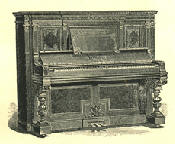
All the qualities of grade III but much more pronounced and extensive carving. Excellent Condition - Sometimes carved on all surfaces of the piano. A very rare cabinet usually custom built by famous furniture manufacturers for very wealthy customers who actually took them a new piano and had them construct a new cabinet. Gustav Stickly was one furniture maker who did this. Only about one of 1000 pianos will be like this. Carved ladies, lions, faces and extensive flowers will elevate a would be grade III to this level.
The Victorian era was named for England's Queen Victoria, who ruled Britain from 1837 to 1901. Stylistically it was an age of romance and eclecticism. After a century and a half of logical and orderly neoclassical design, Victorian style burst forth with its ideals of abundance, imagination and diverse cultural richness. At the height of this Rococo Revival period in America, the pianos were bedecked with garlands, floral swags, scrolls, ribbons of sinuous leaves and vines, cornucopia and blossoms.
In the Victorian era pianos were viewed as a universal symbol of culture, breeding and refinement. In the 1880's, with the onset of the Industrial Revolution, mass production of pianos began in the United States. Piano manufacturers embraced the industrial techniques of interchangeable parts and coupled them with an assembly line. The resulting efficiencies led to extraordinary price reductions. Victorian details were factory produced, making elaborate decorations affordable to a broader public. Decorative motifs ranged widely-from classical designs to floral patterns to repetitive geometric forms. These cabinets are usually Rosewood or Mahogany since that was the choice wood of the day. Circa 1875 to 1899.
GRADE V - ARTISTIC CASE PIANOS
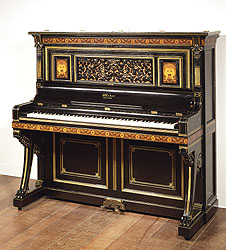
Weber Upright Piano, New York
1876
This piano's case features elaborate carving, inlay, and Marquetry created by the famous New York cabinetmakers, Herter Brothers. Albert Weber emerged as a new rival of Steinway in the 1870s and created this piano especially for the 1876 Centennial Exposition in Philadelphia.
A true Artistic Case is a rare beast to find. Each was made to order, a one of a kind creation. Famous furniture makers (such as Greene & Greene and Stickley) would be brought a single piano from an elite company such as Baldwin or Emerson. They would then reconstruct the case to their own design whims. Other furniture creators would sometimes carve every surface of the body. The Art Cases that have survived are mainly found as specimens in museums.
Vintage upright pianos found on this page do not technically fall into the Artistic Case category, but because they have so many lavish design elements, they can be seen as cousins of this elite group. On these adorned pianos, there are always turned columns, exquisite decorations and embellished architectural panels of great intricacy. A combination of classical themes and various historical motifs were utilized in the delicate moldings, carved pilasters and solid trusses.
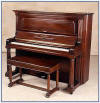
Pianos with key covers that lift are automatically reduced one grade. A key cover should fold up and back in two pieces. Extra small pianos below 52" in height deduct 1 grade point. Most 1 piece fallboard pianos are small, therefore deduct two points. Most 1 piece fallboard pianos are circa 1875-1895 and are Victorian by nature. One may assume they are grade IV pianos but they are usually of inferior construction to the larger later pianos. Most pianos before 1915 can he considered antiques since they do not resemble contemporary styles and truly reflect the creative attitudes of the Victorian Era. Pianos after World War 1 are usually plain and valued for their musical qualities alone. Extra Pilasters on top-usually 4, or extra legs usually 4 or 6 can elevate a grade 1 point if it is nicely done.